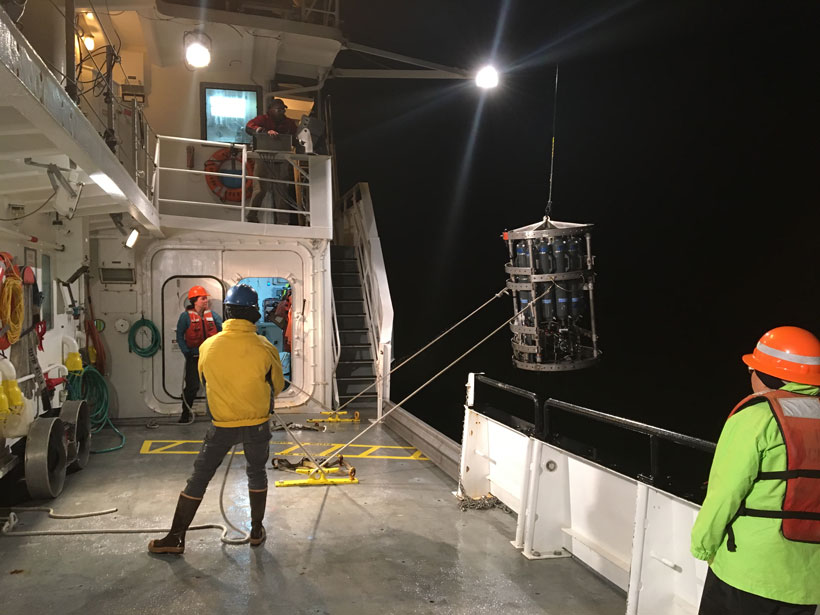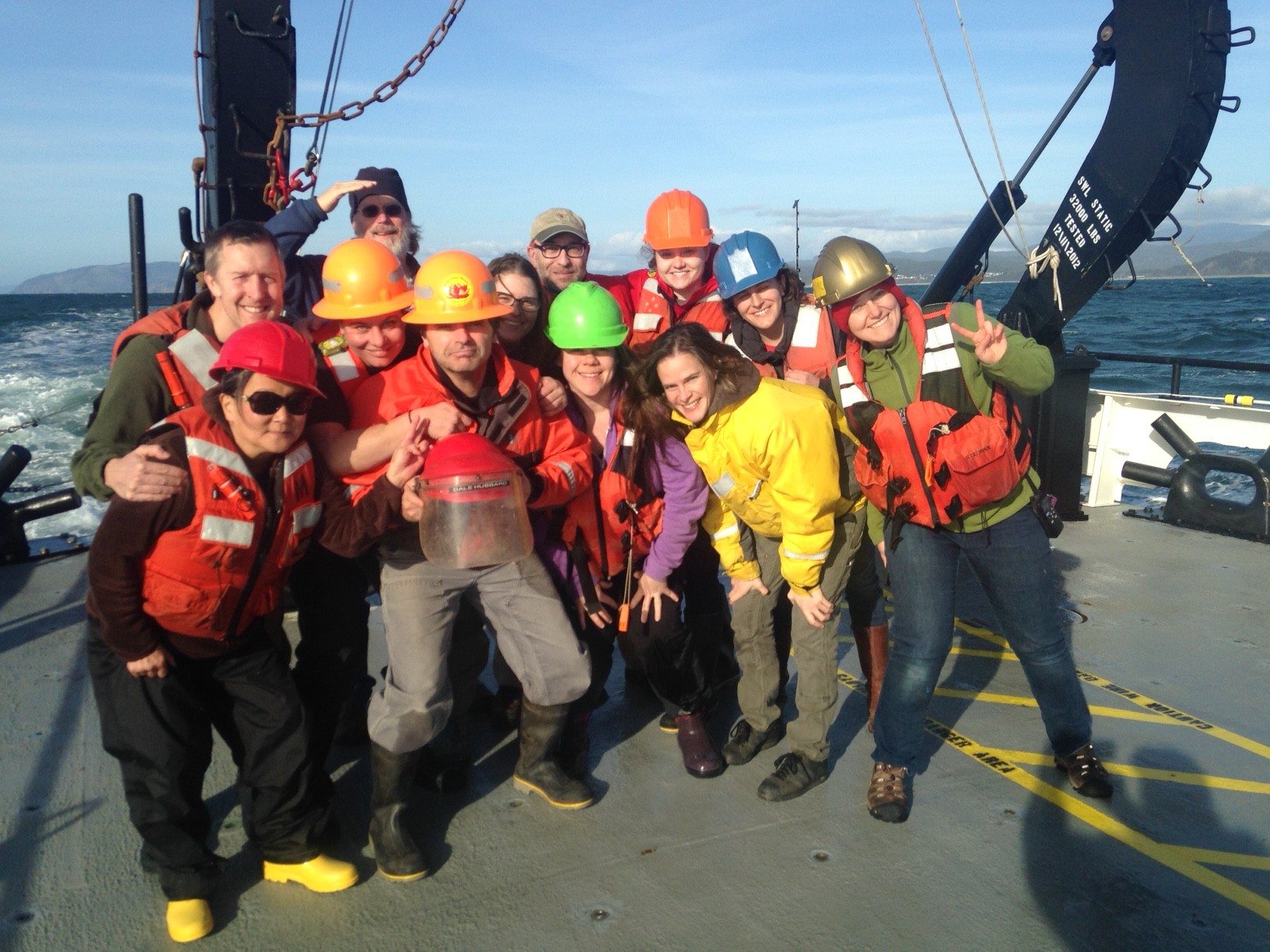28 March 2016
What are scientists doing off the Oregon coast in the middle of winter?
Posted by Shane Hanlon
Social media and the value of communicating field experiences to the public
–This is a cross-posting from an article originally published on the AGU Editors’ Vox blog. The original post is here.
I’m standing in the pouring rain on the deck of the R/V Oceanus in the middle of winter collecting sea water samples. As the boat rocks back and forth, our team carefully lowers the 800-pound CTD, a common oceanographic research instrument that gives scientists detailed information about the water column. Another group deploys instruments off the back of the ship to examine the ocean’s mixing and light penetration.
Later today, we will occupy a series of stations extending across the shelf, from plumes of less-salty water coming from flooding rivers along the Oregon coast to the well-mixed open ocean. Our objective is to decipher whether or not these inputs of freshwater and nutrients trigger coastal plankton blooms during the winter, a period normally considered unproductive. Our research team, led by biological oceanographer Angel White, physical oceanographer Kipp Shearman, and myself, a chemical oceanographer, think that winter plankton productivity may be very important because it can fuel coastal food webs during periods of otherwise low food supply.
In a year from now, the results from this ocean research cruise may end up in a journal paper or a poster presentation. The methods section will likely consist of a few dryly worded sentences: Water samples were taken every XX hours at YYY. But behind all of these published results are dozens of days spent on a rolling ocean and countless hours at the lab bench processing samples. 
Oceanographic field work isn’t always glamorous – the ship is noisy, the days are long, the weather can be rough – but as many scientists know, ship-based measurements are critical to understanding what is going on in our environment. Moreover, these types of measurements are made possible through invaluable contributions from a group of people – from marine technicians to the ship’s captain and crew – who rarely get fully acknowledged and whose work is poorly understood by the public at large or even scientists in other fields.
As the Editor-in-Chief of Journal of Geophysical Research: Biogeosciences , I often think about how to best communicate our field experiences as oceanographers and Earth scientists to the larger public. As important as it is to showcase our scientific results and conclusions, I think it is equally important to show the public and other scientists how we get things done. Many of us got in these fields because of our love of the outdoors, the ocean, forests, and mountains, and are constantly reminded of the amazing experiences and places we get to work in to pursue our passion and do our jobs. Communicating that amazement to the public is something field-scientists could do much more effectively to engage the public in science.
Over the past couple of months, my colleagues and I have been sailing on the R/V Oceanus studying the coastal ocean in the wintertime to understand how small rivers could be influencing the ocean’s productivity during this period. On our most recent cruise, Nanci Bompey from AGU’s public information office joined us on the ship to document the cruise for AGU’s GeoSpace blog[https://blogs.agu.org/geospace/] and social media channels [http://about.agu.org/get-social/]. Being a social media neophyte, I am relying on Nanci to see our experiences with new eyes and communicate ‘routine’ operations, such as donning the survival suit during safety drills [https://www.instagram.com/p/BCy6u5XtBcE/?taken-by=americangeophysicalunion], deploying the CTD rosette, processing water samples and dealing with weather delays with a fresh perspective. You can follow our journey here.
 Ocean research cruises may seem like any day in the office to scientists, but to many people, even finding out what we eat and where we sleep may be exciting. Describing and illustrating where and how we work can be an effective way to engage the public on the excitement of scientific discovery. It is also a useful reminder to other scientists of the diversity of research that AGU members are involved in. If efforts like this can inspire students to study Earth science or help a geomorphologist appreciate the connections between land and ocean processes, then they are well worth it. Social media allows us to connect directly to the public. They can see, in real-time, how science is done and interact with us directly about what we are doing: from seeing a time-lapse video of the CTD deployment [https://www.youtube.com/watch?v=ElGvn-y_wfs&feature=youtu.be] in the pouring rain to a picture of lunchtime in the galley to a blog post about filtering water samples in the on-ship laboratory.
Ocean research cruises may seem like any day in the office to scientists, but to many people, even finding out what we eat and where we sleep may be exciting. Describing and illustrating where and how we work can be an effective way to engage the public on the excitement of scientific discovery. It is also a useful reminder to other scientists of the diversity of research that AGU members are involved in. If efforts like this can inspire students to study Earth science or help a geomorphologist appreciate the connections between land and ocean processes, then they are well worth it. Social media allows us to connect directly to the public. They can see, in real-time, how science is done and interact with us directly about what we are doing: from seeing a time-lapse video of the CTD deployment [https://www.youtube.com/watch?v=ElGvn-y_wfs&feature=youtu.be] in the pouring rain to a picture of lunchtime in the galley to a blog post about filtering water samples in the on-ship laboratory.
If you are a field scientist, I urge you to consider sharing your experiences with the public and other researchers through a variety of mediums, including AGU’s Postcards from the Field campaign.
Happy sailing!
—Miguel Goni, Editor-in-Chief, JGR-Biogeosciences; email: [email protected]


 The Plainspoken Scientist is the science communication blog of AGU’s Sharing Science program. With this blog, we wish to showcase creative and effective science communication via multiple mediums and modes.
The Plainspoken Scientist is the science communication blog of AGU’s Sharing Science program. With this blog, we wish to showcase creative and effective science communication via multiple mediums and modes.